2006 SUBARU TRIBECA steering
[x] Cancel search: steeringPage 251 of 377
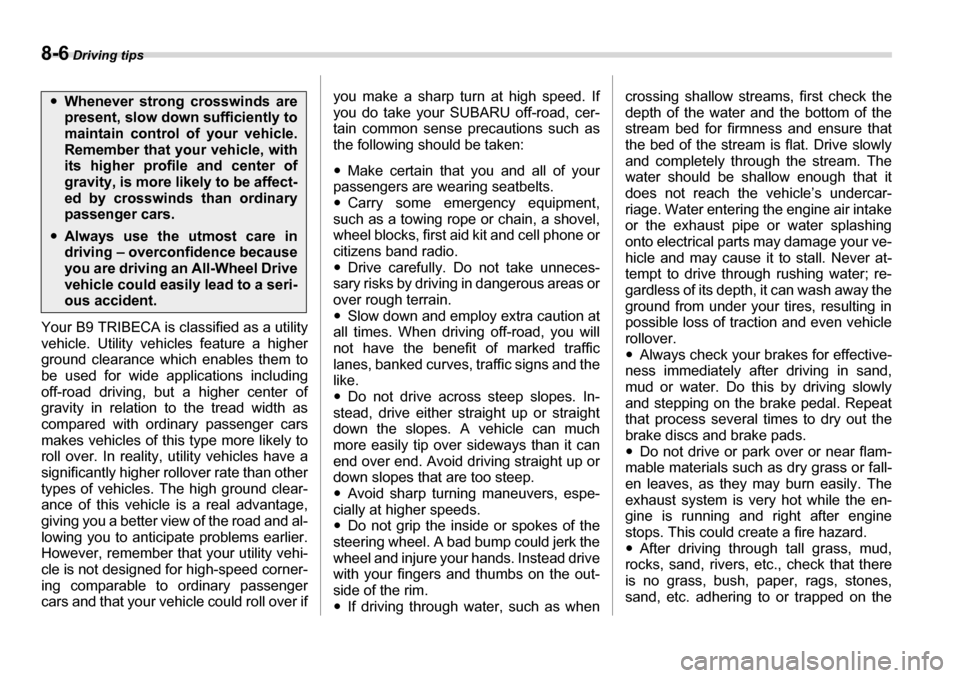
8-6 Driving tips
Your B9 TRIBECA is classified as a utility
vehicle. Utility vehicles feature a higher
ground clearance which enables them to
be used for wide applications including
off-road driving, but a higher center of
gravity in relation to the tread width as
compared with ordinary passenger cars
makes vehicles of this type more likely to
roll over. In reality, utility vehicles have a
significantly higher rollover rate than other
types of vehicles. The high ground clear-
ance of this vehicle is a real advantage,
giving you a better view of the road and al-
lowing you to anticipate problems earlier.
However, remember that your utility vehi-
cle is not designed for high-speed corner-
ing comparable to ordinary passenger
cars and that your vehicle could roll over if you make a sharp turn at high speed. If
you do take your SUBARU off-road, cer-
tain common sense precautions such as
the following should be taken: �y
Make certain that you and all of your
passengers are wearing seatbelts. �y Carry some emergency equipment,
such as a towing rope or chain, a shovel,
wheel blocks, first aid kit and cell phone or
citizens band radio. �y Drive carefully. Do not take unneces-
sary risks by driving in dangerous areas or
over rough terrain. �y Slow down and employ extra caution at
all times. When driving off-road, you will
not have the benefit of marked traffic
lanes, banked curves, traffic signs and the
like. �y Do not drive across steep slopes. In-
stead, drive either straight up or straight
down the slopes. A vehicle can much
more easily tip over sideways than it can
end over end. Avoid driving straight up or
down slopes that are too steep. �y Avoid sharp turning maneuvers, espe-
cially at higher speeds. �y Do not grip the inside or spokes of the
steering wheel. A bad bump could jerk the
wheel and injure your hands. Instead drive
with your fingers and thumbs on the out-
side of the rim.�y If driving through water, such as when crossing shallow streams, first check the
depth of the water and the bottom of the
stream bed for firmness and ensure that
the bed of the stream is flat. Drive slowly
and completely through the stream. The
water should be shallow enough that it
does not reach the vehicle’s undercar-
riage. Water entering the engine air intake
or the exhaust pipe or water splashing
onto electrical parts may damage your ve-
hicle and may cause it to stall. Never at-
tempt to drive through rushing water; re-
gardless of its depth, it can wash away the
ground from under your tires, resulting in
possible loss of traction and even vehiclerollover. �y
Always check your brakes for effective-
ness immediately after driving in sand,
mud or water. Do this by driving slowly
and stepping on the brake pedal. Repeat
that process several times to dry out the
brake discs and brake pads.�y Do not drive or park over or near flam-
mable materials such as dry grass or fall-
en leaves, as they may burn easily. Theexhaust system is very hot while the en-
gine is running and right after engine
stops. This could create a fire hazard.�y After driving through tall grass, mud,
rocks, sand, rivers, etc., check that there
is no grass, bush, paper, rags, stones,
sand, etc. adhering to or trapped on the
�y Whenever strong crosswinds are
present, slow down sufficiently to
maintain control of your vehicle.
Remember that your vehicle, with
its higher profile and center of
gravity, is more likely to be affect-
ed by crosswinds than ordinary
passenger cars.
�yAlways use the utmost care in
driving – overconfidence because
you are driving an All-Wheel Drive
vehicle could easily lead to a seri-
ous accident.
Page 253 of 377
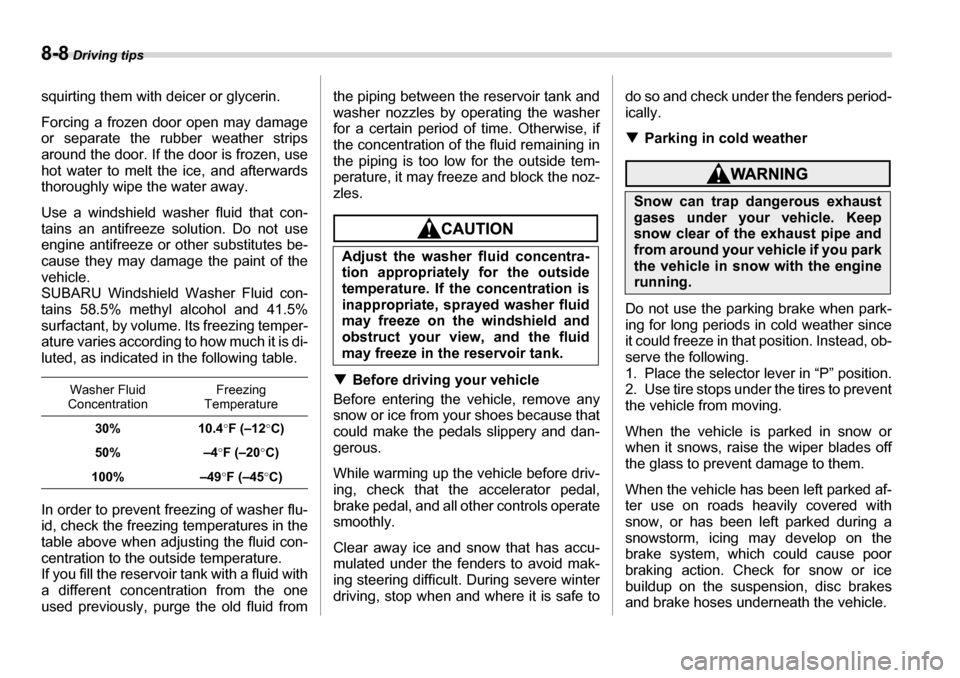
8-8 Driving tips
squirting them with deicer or glycerin.
Forcing a frozen door open may damage
or separate the rubber weather strips
around the door. If the door is frozen, use
hot water to melt the ice, and afterwards
thoroughly wipe the water away.
Use a windshield washer fluid that con-
tains an antifreeze solution. Do not use
engine antifreeze or other substitutes be-
cause they may damage the paint of the
vehicle.
SUBARU Windshield Washer Fluid con-
tains 58.5% methyl alcohol and 41.5%
surfactant, by volume. Its freezing temper-
ature varies according to how much it is di-
luted, as indicated in the following table.
In order to prevent freezing of washer flu-
id, check the freezing temperatures in the
table above when adjusting the fluid con-
centration to the outside temperature.
If you fill the reservoir tank with a fluid with
a different concentration from the one
used previously, purge the old fluid from the piping between the reservoir tank and
washer nozzles by operating the washer
for a certain period of time. Otherwise, if
the concentration of the fluid remaining in
the piping is too low for the outside tem-
perature, it may freeze and block the noz-zles.
�T
Before driving your vehicle
Before entering the vehicle, remove any
snow or ice from your shoes because that
could make the pedals slippery and dan-
gerous.
While warming up the vehicle before driv-
ing, check that the accelerator pedal,
brake pedal, and all other controls operatesmoothly.
Clear away ice and snow that has accu-
mulated under the fenders to avoid mak-
ing steering difficult. During severe winter
driving, stop when and where it is safe to do so and check under the fenders period-
ically. �T
Parking in cold weather
Do not use the parking brake when park-
ing for long periods in cold weather since
it could freeze in that position. Instead, ob-
serve the following.
1. Place the selector lever in “P” position.
2. Use tire stops under the tires to prevent
the vehicle from moving.
When the vehicle is parked in snow or
when it snows, raise the wiper blades off
the glass to prevent damage to them.
When the vehicle has been left parked af-
ter use on roads heavily covered with
snow, or has been left parked during a
snowstorm, icing may develop on the brake system, which could cause poor
braking action. Check for snow or ice
buildup on the suspension, disc brakes
and brake hoses underneath the vehicle.
Washer Fluid
Concentration Freezing
Temperature
30% 10.4 °F (–12 °C)
50% –4 °F (–20 °C)
100% –49 °F (–45 °C)
Adjust the washer fluid concentra-
tion appropriately for the outside
temperature. If the concentration is
inappropriate, sprayed washer fluid
may freeze on the windshield and
obstruct your view, and the fluid
may freeze in the reservoir tank.
Snow can trap dangerous exhaust
gases under your vehicle. Keep
snow clear of the exhaust pipe and
from around your vehicle if you park
the vehicle in snow with the engine
running.
Page 268 of 377
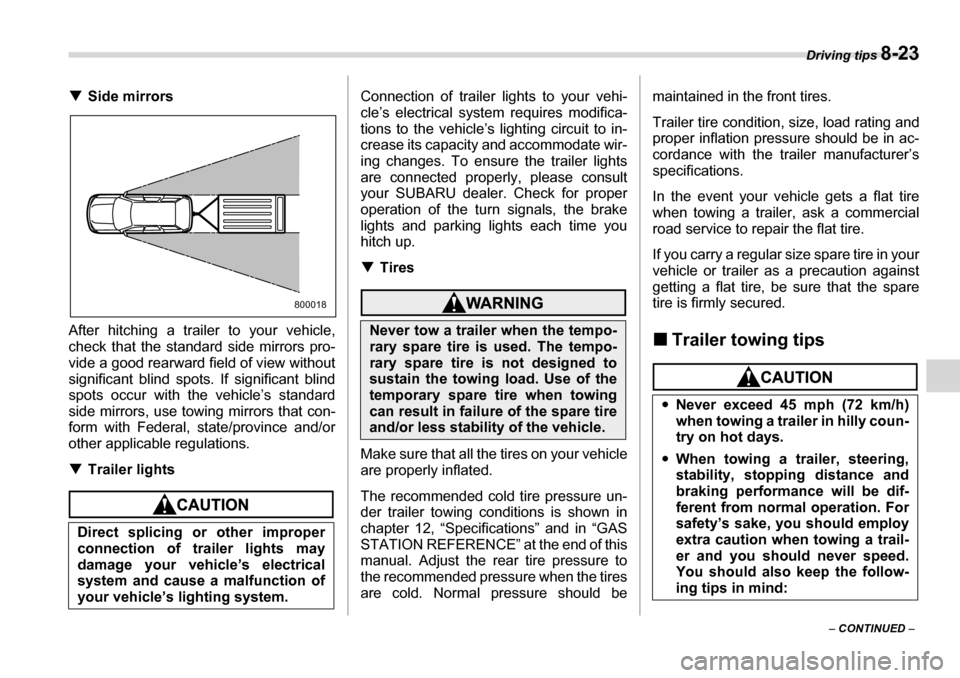
Driving tips 8-23
– CONTINUED –
�T
Side mirrors
After hitching a trailer to your vehicle,
check that the standard side mirrors pro-
vide a good rearward field of view without
significant blind spots. If significant blind
spots occur with the vehicle’s standard
side mirrors, use towing mirrors that con-
form with Federal, state/province and/or
other applicable regulations. �T Trailer lights
Connection of trailer lights to your vehi-
cle’s electrical system requires modifica-
tions to the vehicle’s lighting circuit to in-
crease its capacity and accommodate wir-
ing changes. To ensure the trailer lights
are connected properly, please consult
your SUBARU dealer. Check for proper
operation of the turn signals, the brake
lights and parking lights each time you
hitch up. �TTires
Make sure that all the tires on your vehicle
are properly inflated.
The recommended cold tire pressure un-
der trailer towing conditions is shown in
chapter 12, “Specifications” and in “GAS
STATION REFERENCE” at the end of this
manual. Adjust the rear tire pressure to
the recommended pressure when the tires
are cold. Normal pressure should be maintained in the front tires.
Trailer tire condition, size, load rating and
proper inflation pressure should be in ac-
cordance with the trailer manufacturer’s
specifications.
In the event your vehicle gets a flat tire
when towing a trailer, ask a commercial
road service to repair the flat tire.
If you carry a regular size spare tire in your
vehicle or trailer as a precaution against
getting a flat tire, be sure that the spare
tire is firmly secured. �„
Trailer towing tips
Direct splicing or other improper
connection of trailer lights may
damage your vehicle’s electrical
system and cause a malfunction of
your vehicle’s lighting system.
800018
Never tow a trailer when the tempo-
rary spare tire is used. The tempo-
rary spare tire is not designed to
sustain the towing load. Use of the
temporary spare tire when towing
can result in failure of the spare tire
and/or less stability of the vehicle.
�yNever exceed 45 mph (72 km/h)
when towing a trailer in hilly coun-
try on hot days.
�y When towing a trailer, steering,
stability, stopping distance and
braking performance will be dif-
ferent from normal operation. For
safety’s sake, you should employ
extra caution when towing a trail-
er and you should never speed.
You should also keep the follow-
ing tips in mind:
Page 269 of 377
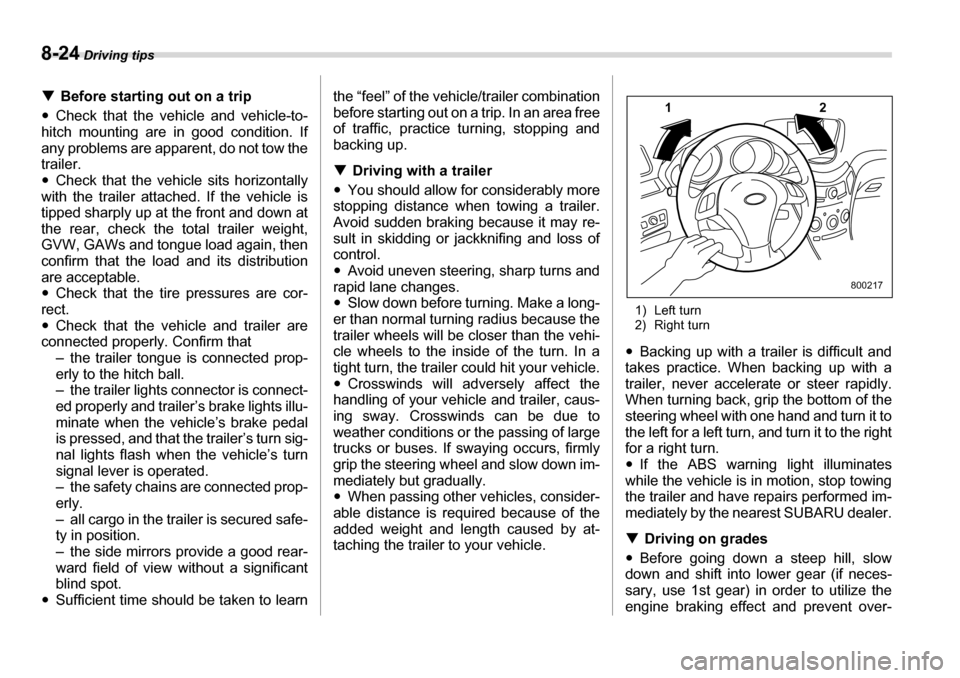
8-24 Driving tips
�TBefore starting out on a trip
�y Check that the vehicle and vehicle-to-
hitch mounting are in good condition. If
any problems are apparent, do not tow the
trailer. �y Check that the vehicle sits horizontally
with the trailer attached. If the vehicle is
tipped sharply up at the front and down at
the rear, check the total trailer weight,
GVW, GAWs and tongue load again, then
confirm that the load and its distribution
are acceptable. �y Check that the tire pressures are cor-
rect. �y Check that the vehicle and trailer are
connected properly. Confirm that – the trailer tongue is connected prop-
erly to the hitch ball.
– the trailer lights connector is connect-
ed properly and trailer’s brake lights illu-
minate when the vehicle’s brake pedal
is pressed, and that the trailer’s turn sig-
nal lights flash when the vehicle’s turn
signal lever is operated.
– the safety chains are connected prop- erly.
– all cargo in the trailer is secured safe- ty in position.
– the side mirrors provide a good rear-
ward field of view without a significant
blind spot.
�y Sufficient time should be taken to learn the “feel” of the vehicle/trailer combination
before starting out on a trip. In an area free
of traffic, practice turning, stopping and
backing up. �T
Driving with a trailer
�y You should allow for considerably more
stopping distance when towing a trailer.
Avoid sudden braking because it may re-
sult in skidding or jackknifing and loss of control.�y Avoid uneven steering, sharp turns and
rapid lane changes.�y Slow down before turning. Make a long-
er than normal turning radius because the
trailer wheels will be closer than the vehi-
cle wheels to the inside of the turn. In a
tight turn, the trailer could hit your vehicle.�y Crosswinds will adversely affect the
handling of your vehicle and trailer, caus-
ing sway. Crosswinds can be due to
weather conditions or the passing of large
trucks or buses. If swaying occurs, firmly
grip the steering wheel and slow down im-
mediately but gradually. �y When passing other vehicles, consider-
able distance is required because of the
added weight and length caused by at-
taching the trailer to your vehicle. 1) Left turn
2) Right turn
�y Backing up with a trailer is difficult and
takes practice. When backing up with a
trailer, never accelerate or steer rapidly.
When turning back, grip the bottom of the
steering wheel with one hand and turn it to
the left for a left turn, and turn it to the right
for a right turn. �y If the ABS warning light illuminates
while the vehicle is in motion, stop towing
the trailer and have repairs performed im-
mediately by the nearest SUBARU dealer. �T Driving on grades
�y Before going down a steep hill, slow
down and shift into lower gear (if neces-
sary, use 1st gear) in order to utilize the
engine braking effect and prevent over-12
800217
Page 289 of 377
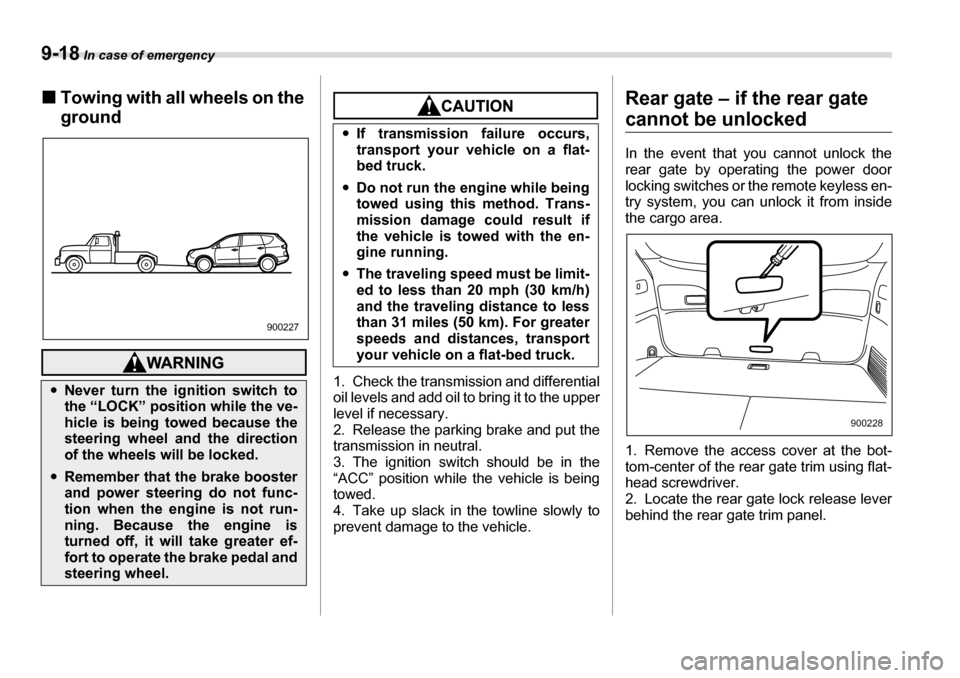
9-18 In case of emergency
�„Towing with all wheels on the ground
1. Check the transmission and differential
oil levels and add oil to bring it to the upper
level if necessary.
2. Release the parking brake and put the
transmission in neutral.
3. The ignition switch should be in the
“ACC” position while the vehicle is being
towed.
4. Take up slack in the towline slowly to
prevent damage to the vehicle. Rear gate – if the rear gate
cannot be unlocked
In the event that you cannot unlock the
rear gate by operating the power door locking switches or the remote keyless en-
try system, you can unlock it from inside
the cargo area.
0
1. Remove the access cover at the bot-
tom-center of the rear gate trim using flat-
head screwdriver.
2. Locate the rear gate lock release lever
behind the rear gate trim panel.
�y
Never turn the ignition switch to
the “LOCK” position while the ve-
hicle is being towed because the
steering wheel and the direction
of the wheels will be locked.
�yRemember that the brake booster
and power steering do not func-
tion when the engine is not run-
ning. Because the engine is
turned off, it will take greater ef-
fort to operate the brake pedal and
steering wheel.
900227
�yIf transmission failure occurs,
transport your vehicle on a flat-
bed truck.
�y Do not run the engine while being
towed using this method. Trans-
mission damage could result if
the vehicle is towed with the en-
gine running.
�y The traveling speed must be limit-
ed to less than 20 mph (30 km/h)
and the traveling distance to less
than 31 miles (50 km). For greater
speeds and distances, transport
your vehicle on a flat-bed truck.
900228
Page 295 of 377
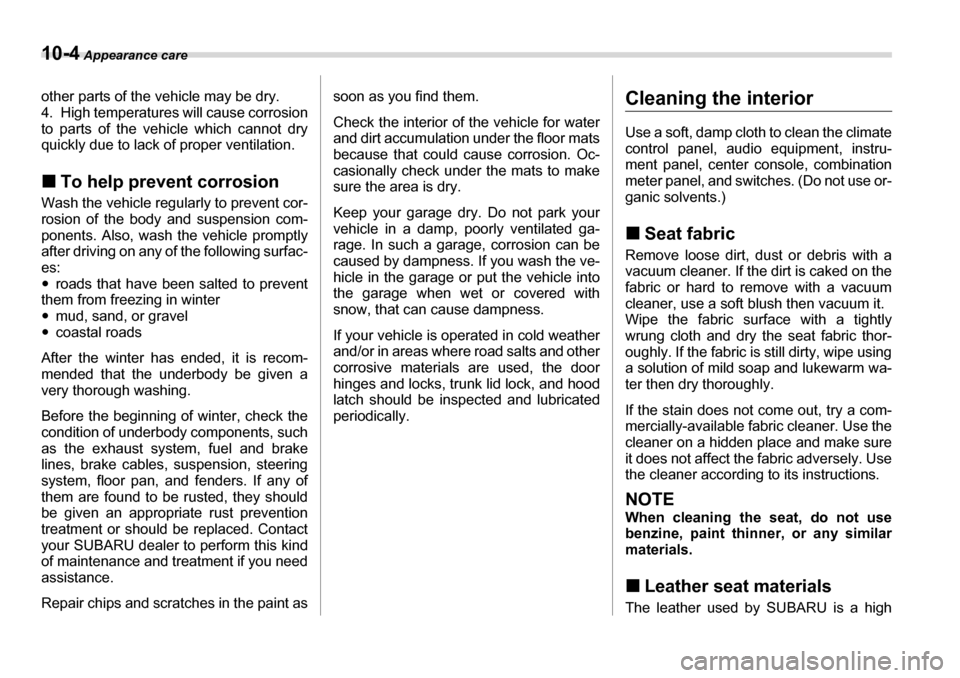
10-4 Appearance care
other parts of the vehicle may be dry.
4. High temperatures will cause corrosion
to parts of the vehicle which cannot dry
quickly due to lack of proper ventilation. �„To help prevent corrosion
Wash the vehicle regularly to prevent cor-
rosion of the body and suspension com-
ponents. Also, wash the vehicle promptly
after driving on any of the following surfac- es: �y roads that have been salted to prevent
them from freezing in winter �y mud, sand, or gravel
�y coastal roads
After the winter has ended, it is recom-
mended that the underbody be given a
very thorough washing.
Before the beginning of winter, check the
condition of underbody components, such
as the exhaust system, fuel and brake
lines, brake cables, suspension, steering
system, floor pan, and fenders. If any of
them are found to be rusted, they should
be given an appropriate rust prevention
treatment or should be replaced. Contact
your SUBARU dealer to perform this kind
of maintenance and treatment if you needassistance.
Repair chips and scratches in the paint as soon as you find them.
Check the interior of the vehicle for water
and dirt accumulation under the floor mats
because that could cause corrosion. Oc-
casionally check under the mats to make
sure the area is dry.
Keep your garage dry. Do not park your
vehicle in a damp, poorly ventilated ga-
rage. In such a garage, corrosion can be
caused by dampness. If you wash the ve-
hicle in the garage or put the vehicle into
the garage when wet or covered with
snow, that can cause dampness.
If your vehicle is operated in cold weather
and/or in areas where road salts and other
corrosive materials are used, the door
hinges and locks, trunk lid lock, and hood
latch should be inspected and lubricated
periodically.Cleaning the interior
Use a soft, damp cloth to clean the climate
control panel, audio equipment, instru-
ment panel, center console, combination
meter panel, and switches. (Do not use or-
ganic solvents.) �„
Seat fabric
Remove loose dirt, dust or debris with a
vacuum cleaner. If the dirt is caked on the
fabric or hard to remove with a vacuum
cleaner, use a soft blush then vacuum it.
Wipe the fabric surface with a tightly
wrung cloth and dry the seat fabric thor-
oughly. If the fabric is still dirty, wipe using
a solution of mild soap and lukewarm wa-
ter then dry thoroughly.
If the stain does not come out, try a com-
mercially-available fabric cleaner. Use the
cleaner on a hidden place and make sure
it does not affect the fabric adversely. Use
the cleaner according to its instructions.
NOTE
When cleaning the seat, do not use
benzine, paint thinner, or any similar
materials. �„ Leather seat materials
The leather used by SUBARU is a high
Page 298 of 377

11
Maintenance and service
Maintenance schedule ....................................... 11-3
Maintenance precautions .................................. 11-3 Before checking or servicing in the engine compartment ........................................................ 11-4
When you do checking or servicing in the
engine compartment while the engine is
running .................................................................. 11-4
Engine hood ....................................................... 11-4
Engine compartment overview ......................... 11-6
Engine oil ............................................................ 11-7 Checking the oil level ............................................. 11-7
Changing the oil and oil filter ................................ 11-7
Recommended grade and viscosity ..................... 11-9
Recommended grade and viscosity under severe driving conditions .................................... 11-10
Cooling system .................................................. 11-10 Hose and connections ........................................... 11-11
Engine coolant ........................................................ 11-11
Air cleaner element ............................................ 11-13 Replacing the air cleaner element ......................... 11-13
Spark plugs ......................................................... 11-14 Recommended spark plugs ................................... 11-14
Drive belts ........................................................... 11-15
Automatic transmission fluid ............................ 11-15 Checking the fluid level ......................................... 11-15
Recommended fluid ............................................... 11-16
Front differential gear oil ................................... 11-16 Checking the oil level ............................................. 11-16 Recommended grade and viscosity ..................... 11-17
Rear differential gear oil .................................... 11-17 Checking the gear oil level .................................... 11-17
Recommended grade and viscosity ..................... 11-18
Power steering fluid ........................................... 11-19 Checking the fluid level .......................................... 11-19
Recommended fluid ............................................... 11-19
Brake fluid ........................................................... 11-20 Checking the fluid level .......................................... 11-20
Recommended brake fluid ..................................... 11-20
Brake booster ..................................................... 11-21
Brake pedal ......................................................... 11-21 Checking the brake pedal free play ...................... 11-21
Checking the brake pedal reserve distance ......... 11-21
Replacement of brake pad and lining ............... 11-22 Breaking-in of new brake pads and linings .......... 11-22
Parking brake stroke .......................................... 11-23
Tires and wheels ................................................ 11-23 Types of tires .......................................................... 11-23
Tire pressure monitoring system (TPMS) ............ 11-23
Tire inspection ........................................................ 11-25
Tire pressures and wear ........................................ 11-25
Wheel balance ......................................................... 11-27
Wear indicators ....................................................... 11-27
Tire rotation ............................................................. 11-28
Tire replacement ..................................................... 11-28
Wheel replacement ................................................. 11-29
Aluminum wheels ............................................... 11-29
Page 303 of 377

11 - 6 Maintenance and service
Engine compartment overview
123 4 5
11
12 10 9 8 67
B00302
1) Air cleaner element (page 11-13)
2) Power steering fluid reservoir (page
11-19)
3) Differential gear oil level gauge (page 11-16)
4) Automatic transmission fluid level
gauge (page 11-15)
5) Brake fluid reservoir (page 11-20)
6) Fuse box (page 11-36)
7) Battery (page 11-35)
8) Windshield washer tank (page 11-30)
9) Radiator cap (page 11-11)
10) Engine oil filler cap (page 11-7)
11) Engine coolant reservoir (page 11-
11)
12) Engine oil level gauge (page 11-7)